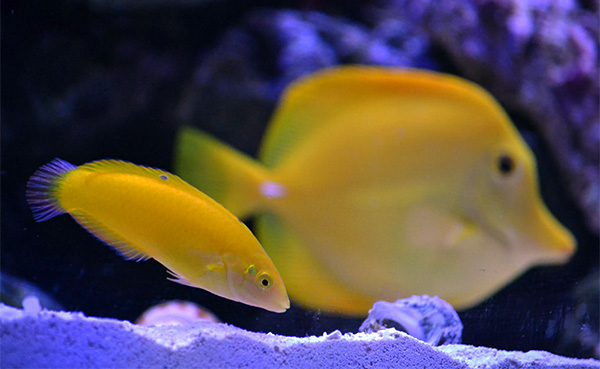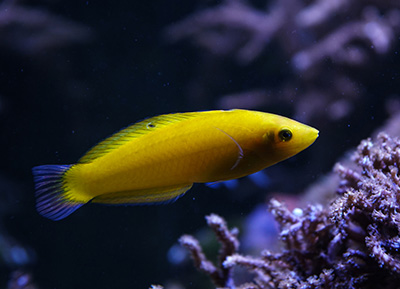Known by a variety of common names—banana wrasse, canary wrasse, golden wrasse, yellow coris, et al—Halichoeres chrysus is hardy, readily available, reasonably affordable, well suited to modest-sized systems, and among the better choices for beginners. Of course, owing to all these positive attributes, this wrasse is justifiably popular among many seasoned salties, as well.
Physical traits
I like to describe the typical wrasse body shape as akin to a banana with fins, which is especially apt for H. chrysus given its coloration. That color, as most of its common names imply, is bright yellow to orange-yellow overall with one to several dark ocelli, or eyespots, in the dorsal fin. Faint green streaks may also be visible on the head. Maximum length is around 4½ inches.
Feeding
In nature, H. chrysus feeds on small invertebrates—crustaceans, worms, mollusks. Aquarium specimens will accept a variety of small meaty foods, such as mysids, chopped crustacean/mollusk flesh, live black worms, etc. This species will predate heavily on amphipods, copepods, and other microfauna in the system, so other fish that depend on these populations for their sustenance, such as mandarins, may not be the best choice for tankmates.
Housing
As mentioned, H. chrysus can be kept in modest-sized aquariums, with 30 gallons being about the minimum. Wrasses are prone to jumping, so be sure to cover the top of the tank, especially when a specimen is newly introduced and hasn’t yet settled in completely. Also, H. chrysus does bury itself at night and when stressed/startled, so a sand substrate of at least a few inches in depth should be provided.

A note on burying: Upon introduction to a new system, it’s not uncommon for this and related species to remain hidden in the substrate for several days to weeks. This behavior is often disconcerting to hobbyists because they don’t know whether their specimen leapt from the tank or is lying dead somewhere in the rockwork. In time—and assuming they aren’t ill, stressed by poor tank conditions, getting bullied by tankmates, etc.—most specimens will get bolder and begin to show themselves more and more frequently.
Compatibility
H. chrysus is a peaceful wrasse that will coexist with most other live-and-let-live species. These wrasses also do well kept in conspecific groups (in suitably sized aquariums, of course), which is always a plus in our hobby.
As far as reef-friendliness is concerned, H. chrysus is a fairly safe choice. Though small crustaceans, worms (including fan worms), and mollusks are likely to become meals, potentially reducing the biodiversity of the system, corals and other sessile invertebrates will generally be left alone.



